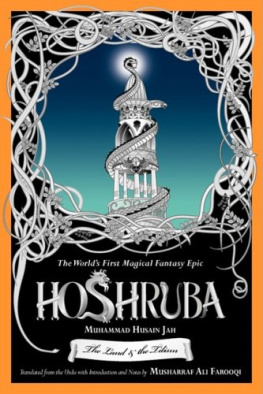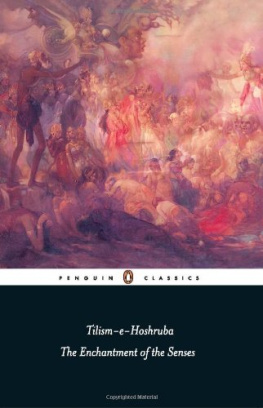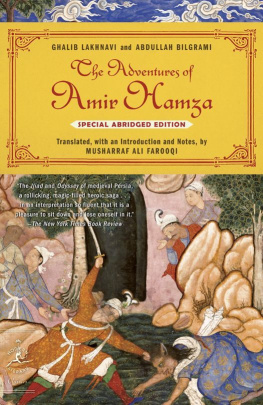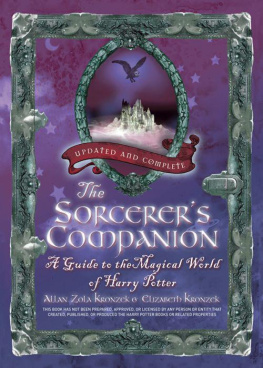Hoshruba: The Land and the Tilism
Chapter 1
The Beginning of the History: Of Amir Hamza the Lord of the Auspicious Planetary Conjunction and the False God Laqa
The deft fingers of narrators weave this splendid legend with the golden thread of sorcery and spread it out thus, before marvelling eyes.
Emperor Naushervan of Persia dreamt one night that a crow coming from the East flew off with his crown, then a hawk flew in from the West, killed the crow and restored him his crown. In the morning he asked the interpretation of this dream from his minister, Buzurjmehr, who was singularly adept in all occult arts. Buzurjmehr made his calculations and replied that in the future a raider named Hashsham from the eastern city of Khaibar would defeat the emperors army and capture his crown and throne. A warrior named Hamza from the western city of Mecca would then appear on the scene and would kill the raider and restore the regalia to the emperor.
Hearing the auspicious news, Naushervan sent Buzurjmehr to Mecca in anticipation of Hamzas birth to declare the boy the emperors protg.
On the day Hamza was born to the chieftain of a tribe, two other boys, named Amar and Muqbil, were also born in Mecca. Buzurjmehr predicted from occult foreknowledge that they would be Hamzas trusted companions. He foretold that Amar would become a devious trickster and Muqbil a matchless archer.
Meanwhile, in the far-away, enchanted land of Mount Qaf, a daughter was born to Emperor Shahpal, the lord of the jinns, fairies and demons. She was named Aasman Peri. Shahpals minister and diviner made her horoscope and revealed that after eighteen years, the demons of Mount Qaf would rebel and overthrow Emperor Shahpal. Then a human being named Hamza would come from the world of men to defeat the demons and restore Shahpal to the throne. The horoscope also disclosed that Hamza would marry Aasman Peri. Upon learning of this, Emperor Shahpal sent for Hamzas cradle from Mecca and kept him in Mount Qaf for seven days. Before he was sent back, Hamza was nursed on the milk of jinns, demons, fairies, ghouls and other beasts to expel the fear of those creatures from his heart.
As Hamza, Amar and Muqbil grew up they met with many adventures and received holy gifts and talents with whose help they triumphed over powerful enemies. Their fame and exploits won them friends and followers. Hamza was chosen as their amir or leader, and became renowned as Amir Hamza. Because he was born under a lucky astrological conjunction of Jupiter and Venus, he was titled the Lord of the Auspicious Planetary Conjunction.
As foretold by Buzurjmehr, Amir Hamza defeated the raider Hashsham who captured Naushervans crown and throne and restored them to the emperor. While at Naushervans court, Amir Hamza fell in love with the emperors daughter, Princess Mehr-Nigar. Their love attracted the notice of Naushervans evil minister, Bakhtak. He was no idle hand at mischief and, suspecting Hamza of carrying on secret trysts with Mehr-Nigar, Bakhtak began to stir trouble at court. Buzurjmehr did his best to protect Amir Hamza but Amir Hamzas amorous passion and reckless trysts with the princess made Buzurjmehr fear for his own reputation.
When the King of India rebelled against Emperor Naushervan, Buzurjmehr saw an opportunity to send Amir Hamza on a far-away campaign. He advised the emperor to promise Princess Mehr-Nigars hand in marriage to the one who would subdue the rebel king. As Buzurjmehr expected, Amir Hamza accepted the challenge, was engaged to Mehr-Nigar, and sent off on the campaign to India.
In Amir Hamzas absence, Bakhtak hatched countless treacherous plots against him with the sanction of the fickle-minded emperor. But Amir Hamza foiled them with the help of his holy gifts, Amar Ayyars cunning stratagems, and Buzurjmehrs assistance. When Amir Hamza returned victorious from his adventures, the palace intrigues continued against him. However, to the shame and chagrin of Naushervan and his court, Mehr-Nigar left to join Hamza.
Meanwhile, the foretold rebellion of demons was underway in the enchanted land of Mount Qaf. Emperor Shahpal sent for Hamza to subdue the rebellious demons. While Amir Hamza was away, Amar Ayyar countered the intrigues and plots hatched by Bakhtak and his son, Bakhtiarak. He defended his camp against Naushervans armies and kept them from carrying away Mehr-Nigar. During his destined eighteen-year stay in Mount Qaf, Amir Hamza quelled the rebellion of the demons, married Aasman Peri and had a daughter with her.
After spending eighteen years in Mount Qaf Amir, Hamza finally returned and married Mehr-Nigar. He married several other women and fairies besides and had many sons and grandsons.
Amir Hamza appointed his grandson, Saad, King of the True Believers but retained command of the armies himself. Many sons were also born to the trickster Amar Ayyar and were appointed tricksters to Amir Hamzas sons.
Amir Hamza and his armies continued to battle tyrants, giants and sorcerers for the glory of the True Faith and encountered and destroyed many tilisms. Amir Hamzas knowledge of the Most Great Name1 protected him against magic and sorcery. Many of these events are recounted in The Adventures of Amir Hamza.
For some time, Amir Hamza was engaged in warfare with the false God Laqa, an eighty-five-foot-tall, pitch-black giant. His head was full of vanity and resembled the ruins of a palace dome; his limbs were the size of giant tree branches. He proclaimed himself God and declared Bakhtiarak, son of Bakhtak, the devil-designate of his court. A great many infidels and sorcerers became Laqas believers. However, the fates and fortunes decided by Laqa always turned out to be false. Calamity and misfortune marked his followers but Laqa had not yet run out of luck.
Of the Tilism Called Hoshruba and the Master of the Tilism, Emperor Afrasiyab
We are told that at the bottom of the untold past, a group of sorcerers met to create a tilism or magical world by using occult sciences2 to infuse inanimate matter with the spirits of planetary and cosmic forces.
In the tilism, the sorcerers exercised powers that defied the laws of God and the physical world. They created illusions, transferred spirits between bodies, transmuted matter, made talismans, and configured and exploited Earths inherent physical forces to create extraordinary marvels.
Once the tilism was created, the sorcerers named it Hoshruba. A sorcerer named Lachin ruled Hoshruba in its early years. Then one of his deputies, the cunning sorcerer Afrasiyab, deposed his master and usurped the throne. Afrasiyab became the Emperor of Hoshruba and Master of the Tilism.
Afrasiyab and his sorceress wife, Empress Heyrat, ruled over Hoshrubas three regions: Zahir the Manifest, Batin the Hidden, and Zulmat the Dark. These regions were also tilisms and contained countless dominions and smaller tilisms filled with thousands of buildings, enclosures, gardens and palaces governed by sorcerer princes and sorceress princesses. Ordinary citizens of Hoshruba lived in the region of Zahir the Manifest. Empress Heyrat and the emperors ministers, peers and confidants made their abode in Batin the Hidden. Zulmat the Dark was a secluded region of Hoshruba to which few had access. It was inhabited by two of Hoshrubas most powerful sorceresses.
An enchanted river called the River of Flowing Blood divided the regions of Zahir and Batin. A bridge that was made of smoke and guarded by two smoke lions stretched over it. It was called the Bridge of the Magic Fairies and from it a three-tiered tower rose to the skies. On the lowest tier of this tower, magic fairies stood alert, holding trumpets and clarions to their lips. From the second tier, another group of magic fairies constantly tossed pearls into the river to the fish that swam, carrying them in their mouths. On the topmost tier, gigantic Abyssinians arrayed in double rows skirmished together with swords. The blood that flowed from their wounds poured into the water below and gave the River of Flowing Blood its name.







